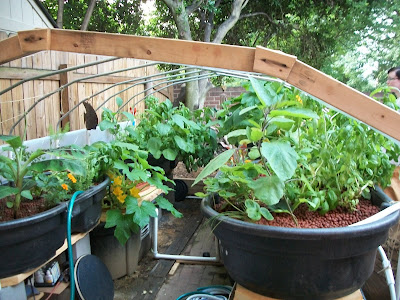My greenhouse aquaponics project (OMG What Have I Done?) has come up in some soon-to-be-published interviews with Eric, so I thought I’d report on my progress…or lack of progress. First of all, the old commercial greenhouse (100 ft by 30 ft by 30 ft high) has been sealed (added side curtains, repaired the fire damage, put up some canvas flap doors on each end (contact local sign and advertising companies for used banners they are throwing away: heavy, hemmed, UV-resistant. Good stuff for temporary fixes.)
I’ve begun seedlings at home under a grow light, mostly tomatoes. I’ve set up a Dutch Bucket hydroponics system (video forthcoming). I’ve given up on the idea of building an inner greenhouse inside the greenhouse (see the writings of Eliot Coleman on winter greenhouse gardening without heat) and instead will drape plastic over existing plants if needed.
Aquaponics – aka aquaculture.
The learning curve is steep, but not daunting. Thanks to GardenFork listener
@CCorbiere who’s offered his considerable experience in fish wrangling and pond design. His knowledge and experience is going to be more than helpful as I get started on the fish side of the equation.

My biggest hurdle seems to be settling on some systems issues, a breed of fish, and –most importantly– trying to start the biologic process in the winter, which is the reason I launched a hydroponics Dutch Bucket system first. Hydroponics is even more “fiddly-fidgety” than aquaponics, but at least you don’t have to try to start bacteria colonies in the cold. I’ll be documenting this process as I go along.
If you need a brief primer on aquaponics you can’t do better than the Flash animations (click the red button to make them work) from EcoFilms Australia: How an Aquaponics System Works. The system demonstrated is the CHOP system (constant height, one pump), which is what I’ll be doing. There is also an excellent animation on the same page about how a Bell Siphon works. (BTW: the Austrailains are way, way ahead of us in aquaculture.)

If you are not familiar with aquaponics, here’s a brief description. Think: Closed Loop Agriculture.
- You feed the fish (organic feed, if you wish)
- the fish poop
- you pump the fish water with the poop to the grow beds (what is called a flood and drain system)
- the medium (usually gravel, but can be other things) hosts bacteria that convert the ammonia in the poop to nitrites and then another bacteria converts the nitrites to nitrates (plant nitrogen)
- plants in the grow beds pick up the nitrogen from the water when the bed floods
- the bell siphon (see video link above) drains the bed after a “dwell” time
- the draining of the bed draws oxygen down into the beds and the root zone for the plants
- the drained water splashes down to the sump, re-oxygenating the water for the fish
- the sump water is pumped back to the fish tank with as much splashing as possible to add more oxygen to the fish tank
- Repeat
- eventually you get a lot of solids built up in your grow bed
- so you add compost worms to the beds (which can breath air and water) to reduce the solids to castings, which become compost tea for the plants
Your only input is fish food and water (to top off the tanks).
Of course there is more to it than this, but that’s the gist of it, a closed-loop, sustainable, agriculture system.
Comments
2 responses to “Aquaponics Part 1”
wow. good luck sir. i watch from here. eric.
Thanks, Eric. However, yesterday I went ahead and built a greenhouse inside the greenhouse. Mostly so I can put the aquaponics fish tank and flood and drain tables under a structure where they will warm up. The well water I’m using is damn cold.
I’ll have some pix of that soon, as well.